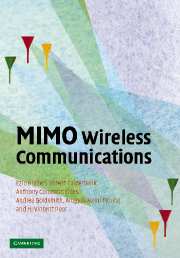Book contents
Preface
Published online by Cambridge University Press: 15 December 2009
Summary
Facies non omnibus una,
Nec diversa tamen
(Ovid, Metamorphoses)Wireless is one of the most rapidly developing technologies in our time, with dazzling new products and services emerging on an almost daily basis. These developments present enormous challenges for communications engineers, as the demand for increased wireless capacity grows explosively. Indeed, the discipline of wireless communications presents many challenges to designers that arise as a result of the demanding nature of the physical medium and the complexities in the dynamics of the underlying network. The dominant technical issue in wireless communications is that of multipath-induced fading, namely the random fluctuations in the channel gain that arise due to scattering of transmitted signals from intervening objects between the transmitter and the receiver. Multipath scattering is therefore commonly seen as an impairment to wireless communication. However, it can now also be seen as providing an opportunity to significantly improve the capacity and reliability of such systems. By using multiple antennas at the transmitter and receiver in a wireless system, the rich scattering channel can be exploited to create a multiplicity of parallel links over the same radio band, and thereby to either increase the rate of data transmission through multiplexing or to improve system reliability through the increased antenna diversity. Moreover, we need not choose between multiplexing and diversity, but rather we can have both subject to a fundamental tradeoff between the two.
This book addresses multiple-input/multiple-output (MIMO) wireless systems in which transmitters and receivers may have multiple antennas. Since the emergence of several key ideas in this field in the mid-1990s, MIMO systems have been one of the most active areas of research and development in the broad field of wireless communications.
- Type
- Chapter
- Information
- MIMO Wireless Communications , pp. xi - xiiPublisher: Cambridge University PressPrint publication year: 2007

